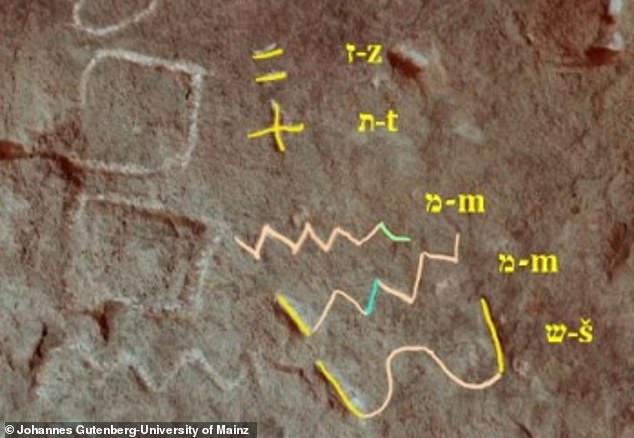[ad_1]
A controversial new interpretation of markings etched on the walls of an ancient Egyptian mine could prove the Book of Exodus to be true.
Researcher Michael Bar-Ron claimed that a 3,800-year-old Proto-Sinaitic inscription, found at Serabit el-Khadim in Egypt‘s Sinai Peninsula, may read ‘zot m’Moshe,’ Hebrew for ‘This is from Moses.’
The inscription, etched into a rock face near the so-called Sinai 357 in Mine L, is part of a collection of over two dozen Proto-Sinaitic texts first discovered in the early 1900s.
These writings, among the earliest known alphabetic scripts, were likely created by Semitic-speaking workers in the late 12th Dynasty, around 1800BC.
Bar-Ron, who spent eight years analyzing high-resolution images and 3D scans, suggested the phrase could indicate authorship or dedication linked to a figure named Moses.
According to the Bible, Moses led the Israelites out of slavery in Egypt, and is famously known for receiving the Ten Commandments from God on Mount Sinai. But no evidence of his existence has ever been found.
Other nearby inscriptions reference ‘El,’ a deity associated with early Israelite worship, and show signs of the Egyptian goddess Hathor’s name being defaced, hinting at cultural and religious tensions.
Mainstream experts remain cautious, noting that while Proto-Sinaitic is the earliest known alphabet, its characters are notoriously difficult to decipher.

An independent researcher has re-examined ancient markings in Egypt, suggesting a phrase could be the first words of Moses. He said it reads: ‘This is from Moses’
Dr Thomas Schneider, Egyptologist and professor at the University of British Columbia, said the claims are completely unproven and misleading,’ warning that ‘arbitrary’ identifications of letters can distort ancient history.’
However, Bar-Ron’s academic advisor, Dr Pieter van der Veen, confirmed the reading, stating, ‘You’re absolutely correct, I read this as well, it is not imagined!’
Bar-Ron’s study, which has not been published in a peer-reviewed journal, re-examined 22 complex inscriptions from the ancient turquoise mines, dating to the reign of Pharaoh Amenemhat III.
Some scholars have proposed that Amenemhat III, known for his extensive building projects, could have been the pharaoh mentioned in the Book of Exodus.
The language used in the carvings appears to be an early form of Northwest Semitic, closely related to biblical Hebrew, with traces of Aramaic.
Using high-resolution images and 3D casts studied at Harvard’s Semitic Museum, Bar-Ron grouped the inscriptions into five overlapping categories, or ‘clades,’ including dedications to the goddess Baʿalat, invocations of the Hebrew God El and hybrid inscriptions that show signs of later defacement and modification.
Some carvings honoring Baʿalat appeared to have been scratched over by El-worshippers, possibly reflecting a religious power struggle among the Semitic-speaking laborers.
The inscriptions also contained references to slavery, overseers, and a dramatic rejection of the Baʿalat cult, which scholars suggest may have led to a violent purge and the workers’ eventual departure from the site.

The 3,800-year-old Proto-Sinaitic inscription were found at Serabit el-Khadim in Egypt’s Sinai Peninsula. They littered the rock walls of an ancient mine

The researchers also identified text dedicated to ancient Egyptian gods that appeared scratched off and replaced with the Hebrew God
A burned Ba’alat temple, built by Amenemhat III, and references to the ‘Gate of the Accursed One, likely Pharaoh’s gate, hint at resistance against Egyptian authority.
Nearby, the Stele of Reniseneb and a seal of an Asiatic Egyptian high official indicate a significant Semitic presence, possibly linked to figures like the biblical Joseph, a high-ranking official in Pharaoh’s court, as described in the Book of Genesis.
Joseph, sold into slavery and later rising to power through his dream interpretations, facilitated his family’s settlement in Egypt.
‘We find worshipful inscriptions lauding the idol Ba’alat, with clearly an El or God-serving scribe coming in later and canceling out certain letters, in an effort to turn the message into a God-serving one,’ Bar-Ron told Patterns of Evidence.

A second reference to Moses was found inside the mine, but the researchers is unclear about the context
‘This is ground zero for this conflict.
A second possible ‘Moshe,’ or Moses, reference in nearby carvings adds intrigue, though its exact context remains unclear.
‘I took a very critical view towards finding the name ‘Moses’ or anything that could sound sensationalist,’ Bar-Ron told Patterns of Evidence.
‘In fact, the only way to do serious work is to try to find elements that seem ‘Biblical,’ but to struggle to find alternative solutions that are at least as likely.’
[ad_2]
This article was originally published by a www.dailymail.co.uk . Read the Original article here. .

